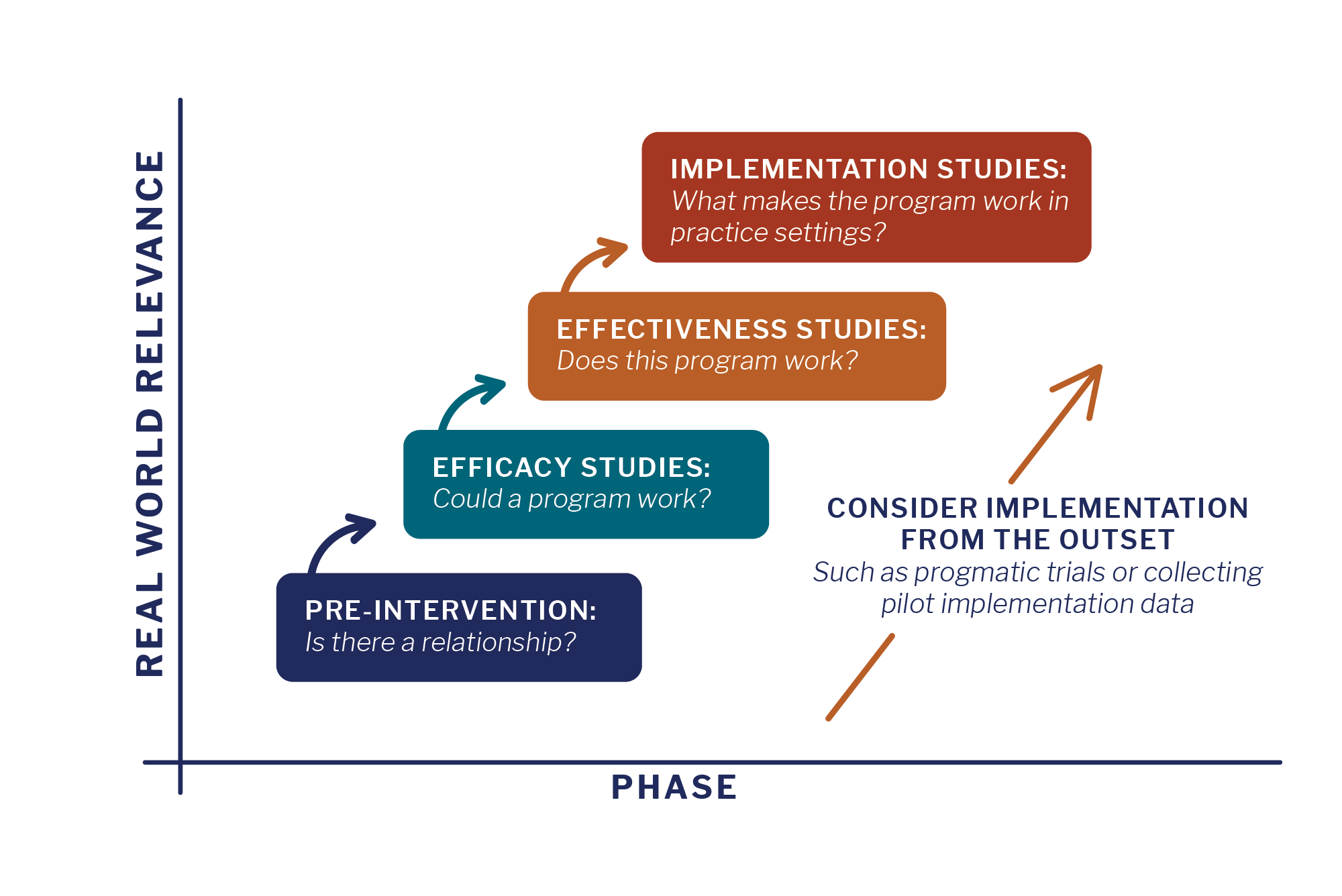For more information:
Email UsImplementation Science
According to the National Cancer Institute, Implementation Science (IS) aims to accelerate the adoption and integration of evidence-based practices, interventions, and policies into routine healthcare and public health practice to improve the impact on population health. By using IS, researchers can help bridge the divide between research and practice and bring programs that work to communities in need. Applying IS may help you understand how to best use specific interventions and strategies that have been proven to work in similar settings.¹
Dissemination refers to the intentional process of spreading information and interventions to a target audience, while implementation is the process of integrating a specific intervention into practice within an organization or system.
Evidence-Based Interventions
Evidence-Based Interventions (EBIs) are the subject of dissemination and implementation efforts with proven efficacy and effectiveness. These include programs such as the Diabetes Prevention program, practices like cervical cancer screening, and policies such as smoke-free housing rules. It is important to evaluate the existing evidence for any intervention before engaging in implementation and dissemination efforts.
Implementation Strategies
Implementation strategies (IS) are the specific means for adopting, integrating, and sustaining evidence-based interventions – the “how to” components of change. IS researchers have identified a range of implementation strategies.² Examples include capacity-building trainings and patient navigation.
¹Implementation Science at a Glance: A Guide for Cancer Control Practitioners
²A refined compilation of implementation strategies: results from the Expert Recommendations for Implementing Change (ERIC) project
Translational Research Continuum

View image description.
Figure adapted from Landsverk et al, Chapter 12, figure 12-1. Stages of research and phases of dissemination and implementation research, in Brownson, Colditz and Proctor 2012, Dissemination and Implementation in Health: Translation Science to Practice, Oxford: Oxford University Press.
Sample Implementation Science Research Questions
- What strategies are best to integrate an EBI into a healthcare or community setting?
- What factors influence intervention success?
- How can interventions be designed so they become embedded in organizations for sustained impact?
- How can we adapt effective interventions to fit different settings?
- What levels of intervention implementation yield what the organization or best practices define as an acceptable levels of change?
Commonly Used Terms
- Adoption: the decision of an organization, community, or other actor to initiate an EBI.
- Adaptation: intentional changes to the EBI to increase impact and relevance.
- Fidelity: the degree to which an EBI is implemented as originally described.
- Sustainability: the extent to which an EBI can deliver its intended benefits over an extended period of time.
Models and Frameworks
Models and frameworks used in implementation science help us to understand how to achieve success in implementation. They can guide our planning, implementation, and evaluation, including defining the constructs for which we measure the impact of an EBI.
Selecting a framework will depend on your research questions. For example, some frameworks focus on how to evaluate implementation outcomes such as acceptability, costs, feasibility, and fidelity (e.g. The Proctor Model), while others focus on how determinants within varying contextual domains influence implementation outcomes (e.g. Consolidated Framework for Implementing Reserach). Read more about selecting a model or framework for your research.
Other Resources:
- Introduction to Implementation Research: Harvard Catalyst’s eight-week online course offers an opportunity for investigators who want to understand and apply implementation science methods to their research.
- Implementation Science at a Glance: This guide designed for practitioners provides an excellent introduction to the field and offers strategies for engaging stakeholders and partners and balancing adaptation and fidelity.
- Implementation Science Made too Simple: A Teaching Tool – Provides a brief overview of implementation science and how it relates to effectiveness research using “very non-scientific language”.
- Training Institute for Dissemination and Implementation Research in Cancer (TIDIRC): For more in-depth learning, try these open access modules.
- Implementation Science Webinars Series and Research to Reality Cyber Seminars: To keep up with the latest in implementation science, check out this webinar series from the National Cancer Institute.
- An Introduction to Effectiveness, Dissemination and Implementation Research: This resource manual includes recommendations to enhance integration of research and practice.
- PCORI Dissemination and Implementation Framework and Toolkit: These companion resources focus on dissemination and implementation of comparative effectiveness research and patient centered outcome research findings with the potential to have considerable impact on health and healthcare decision making.
- The Implementation Science Resource Navigator: This is a curated, guided website that organizes web-based implementation research resources by topic and easy-to-use links.

